Brighten up your low-light rooms with the right paint colors. Opt for lighter, warmer shades that enhance the available light and create a welcoming atmosphere. Explore nine eye-catching hues that can transform any dark corner into a visually inviting space.
Lavender: Versatile and Refreshing for Low-Light Rooms

When it comes to adding a touch of elegance and tranquility to low-light rooms, lavender is a versatile color choice that offers a wide range of options.
From subtle and barely-there tints to deeper and dusky violet hues, lavender can create a soothing and refreshing atmosphere. Whether you prefer a more sophisticated look or want to embrace playful and vibrant tones, lavender can be paired with various colors to achieve the desired effect.
In this guide, we will explore different ways to incorporate lavender into your low-light rooms, providing inspiration for both subtle and bold color combinations.
Lavender with Gray, Black, and White:.
For a sophisticated and calming ambiance, combine lavender with shades of gray, black, and white.
Paint the walls in a light lavender hue and complement it with gray furniture, black accents, and white trimmings. This monochromatic color scheme creates a serene and elegant atmosphere, perfect for bedrooms or living spaces where relaxation is key.
Use lavender as an accent color in the form of pillows, curtains, or artwork to maintain a cohesive and soothing palette. Lavender with Bold Purples and Blues:.
If you’re looking to create a more vibrant and playful environment, consider pairing lavender with bold purples and blues.
Use lavender as the dominant color and introduce deeper shades of purple and blue as complementary accents. For example, paint the walls in a soft lavender shade and incorporate deeper purple or indigo furnishings such as sofas or chairs.
Add pops of brighter purples and blues through decorative accessories like pillows, rugs, or artwork. This color combination injects energy and liveliness into low-light rooms, making them feel dynamic and visually engaging.
Lavender in Combination with Neutrals:.
Lavender can also be combined with neutral colors for a balanced and versatile look.
Pair lavender with shades of beige, cream, or light brown to create a soft and warm atmosphere. Use lavender as an accent color through bedding, curtains, or decorative items, while keeping the majority of the space neutral.
This combination works well in bedrooms or cozy reading nooks, where a calming and inviting ambiance is desired. Additional Tips:.
Consider the lighting in your low-light room and choose lavender shades that work well with the available natural or artificial light.
Experiment with different textures and materials to enhance the overall aesthetic. Incorporate soft fabrics, such as velvet or silk, in lavender tones for added elegance.
Use lavender-scented candles or diffusers to further enhance the calming and soothing effect of the color. .
Pale Yellow: Mimicking Natural Light with a Sunny Glow
When it comes to brightening up a room and creating the illusion of natural light, pale yellow is an excellent choice.
Its light and buttery hues reflect artificial light beautifully, without overwhelming the space like bolder shades might. By incorporating pale yellow walls into your interior design, you can create a sunny and inviting atmosphere. In this guide, we will explore different ways to enhance the classic look of yellow interiors, using white woodwork and warm wood tones to complement the pale yellow walls.
Choosing the Right Shade of Pale Yellow:.
When selecting a pale yellow shade, opt for lighter tones that mimic the softness of natural sunlight.
Look for hues that have a touch of warmth and avoid yellows that are too cool or greenish. Test paint samples on your walls and observe how they interact with the available light in your room to find the perfect pale yellow shade.
Pale Yellow Walls with White Woodwork:.
Pairing pale yellow walls with white woodwork creates a classic and timeless look.
Paint the walls in your chosen shade of pale yellow and use white paint for the trim, baseboards, and moldings. The contrast between the pale yellow walls and the crisp white woodwork adds depth and elegance to the space.
This combination works well in various rooms, including living rooms, kitchens, and bedrooms, where a fresh and airy ambiance is desired. Warm Wood Tones as Complementary Elements:.
Incorporate warm wood tones into your design to further enhance the classic look of yellow interiors.
Choose wooden furniture, such as tables, chairs, or cabinets, in warm tones like honey oak, walnut, or cherry. The combination of pale yellow walls, white woodwork, and warm wood tones creates a harmonious and inviting atmosphere.
This color palette is particularly well-suited for traditional or farmhouse-style interiors, adding a cozy and rustic touch. Additional Tips:.
Consider the natural and artificial lighting in your space when selecting a pale yellow shade.
Test how the color appears under different lighting conditions to ensure it maintains its warm and luminous quality. Use lighter furniture upholstery or curtains in neutral tones, such as white, cream, or beige, to complement the pale yellow walls and create a balanced look.
Introduce accents of soft pastel colors, such as light blue or pale green, to add depth and interest to the space without overpowering the pale yellow backdrop. .
Chocolate Brown: Creating a Cozy and Inviting Space

When it comes to dark paint colors for low-light rooms, chocolate brown is a standout option.
Unlike some darker shades that can make a space feel smaller and more confining, chocolate brown has a warm and inviting quality that brings coziness to the room. By using this rich hue strategically and balancing it with light accents, you can create a well-balanced and visually appealing space.
In this guide, we will explore different ways to make the most of chocolate brown in a low-light room and create a cozy atmosphere.
Selecting the Right Shade of Chocolate Brown:.
Choose a chocolate brown shade that has warm undertones, such as reddish or golden hues.
Avoid brown tones that are too cool or grayish, as they can make the room feel gloomy. Test paint samples on the walls and observe how they interact with the available light to find the perfect chocolate brown shade that suits your space.
Balance with Light Accents:.
To prevent the room from feeling too heavy, balance the chocolate brown walls with light accents.
Use white or light-colored woodwork, such as trim, baseboards, and crown moldings, to create a contrasting effect against the dark walls. Consider installing light-colored carpeting or rugs to provide a visual break and add brightness to the floor area.
Choose light-colored furniture upholstery or drapery to create a sense of balance and prevent the space from feeling too dark. Incorporate Patterned Fabrics:.
Introduce patterned fabrics in lighter colors to add visual interest and further enhance the balance in the room.
Use Throw Pillows, curtains, or upholstery with patterns that incorporate chocolate brown along with lighter shades, such as cream, beige, or soft pastels. Patterns can help break up the solid expanse of chocolate brown and add depth and texture to the space.
Lighting Considerations:.
Enhance the overall ambiance by incorporating different lighting sources.
Utilize ambient lighting, such as ceiling fixtures or floor lamps, to provide overall illumination. Use accent lighting, such as table lamps or wall sconces, to create focal points and highlight specific areas of the room.
Consider adding mirrors strategically to reflect light and create the illusion of more space. Additional Tips:.
Keep the room clutter-free and well-organized to maintain a sense of openness and prevent the space from feeling cramped.
Consider incorporating natural elements, such as indoor plants or wooden accessories, to add warmth and create a connection to nature. Experiment with different textures in your decor, such as plush fabrics or woven materials, to add depth and tactile interest to the room.
.
Powder Blue: Bringing Timeless Freshness to Dark Spaces
When it comes to brightening up a dark corner or low-light room, powder blue is a timeless color choice that can infuse freshness and lightness into the space.
This delicate shade of blue has a calming and uplifting effect, making it well-suited for various interior styles. Whether you prefer a traditional look with crisp white accents or a retro vibe with vibrant color combinations, powder blue can transform a dark space into a visually appealing and inviting area. In this guide, we will explore different ways to make the most of powder blue and create a bright and refreshing atmosphere.
Selecting the Right Shade of Powder Blue:.
Opt for a soft and light shade of blue with cool undertones to achieve the desired effect.
Consider testing different paint samples on the walls and observe how they interact with the available light to find the perfect powder blue shade for your space. Choose a shade that complements your existing furnishings and decor elements.
Pairing with Crisp White Details:.
To enhance the brightness and freshness of powder blue, pair it with crisp white details.
Use white trim, baseboards, crown moldings, and other architectural elements to create a clean and classic look. Incorporate white furniture pieces, such as chairs, tables, or shelving, to add contrast and create a sense of openness.
Embracing Traditional Interiors:.
Powder blue works particularly well in traditional interiors when paired with dark wood furnishings and deep red tones in upholstery.
Consider using dark wood furniture pieces, such as a dining table, bookshelf, or sideboard, to add warmth and richness to the space. Choose upholstery fabrics in deep red tones, such as burgundy or cranberry, to create a harmonious and sophisticated color palette.
Adding Retro Flair:.
For a retro-inspired look, experiment with vibrant color combinations alongside powder blue.
Introduce accents in cherry red or lime green to create a playful and nostalgic atmosphere. Incorporate these vibrant colors through accessories, such as throw pillows, rugs, artwork, or even painted furniture pieces.
Lighting Considerations:.
Enhance the brightness of powder blue by optimizing lighting in the room.
Maximize natural light by keeping windows uncovered or using sheer curtains that allow light to filter through. Supplement natural light with well-placed artificial lighting, such as ceiling fixtures, table lamps, or wall sconces, to create a well-lit and inviting ambiance.
Additional Tips:.
Consider incorporating natural elements, such as indoor plants or natural fibers, to add texture and a sense of freshness to the space.
Use reflective surfaces, such as mirrors or metallic accents, to amplify the light and create a sense of spaciousness. Opt for light-colored flooring, such as light wood or pale carpeting, to further enhance the brightness and airy feel of the room.
Warm Orange: Infusing Radiance and Warmth into Dark Spaces

When it comes to brightening up a dark space and creating a warm and inviting atmosphere, warm shades of orange are an excellent choice.
From apricot to pumpkin and tangerine, these hues have the power to Transform a room with limited light sources into a cozy gathering place. The radiant glow of orange, whether illuminated by lamps, candlelight, or natural sunlight, can add vibrancy and a sense of warmth to any interior.
In this guide, we will explore the transformative qualities of warm orange and how to make the most of this color in dark spaces.
Selecting the Right Shade of Warm Orange:.
Consider various shades of orange, such as apricot, pumpkin, or tangerine, to find the one that resonates with your desired atmosphere.
Test different paint samples on the walls to see how they interact with the available light and complement the existing elements in the room. Opt for warm orange shades with earthy undertones to create a cozy and inviting ambiance.
Enhancing with Lighting:.
Orange hues have a unique ability to radiate and glow when illuminated by different light sources.
Maximize the effect of warm orange by incorporating various lighting options, such as lamps, candlelight, or sconces, to create a soft and inviting glow. Experiment with different types of lighting fixtures and bulbs to find the right balance of warmth and brightness.
Pairing with Neutral Tones:.
To balance the vibrant and energetic nature of warm orange, pair it with neutral tones.
Use shades of white, beige, or light gray for the walls, ceiling, and larger furniture pieces to create a backdrop that allows the orange to shine. Incorporate natural textures and materials, such as wood or rattan, in neutral tones to add warmth and depth to the space.
Adding Complementary Accents:.
Introduce accents and accessories in complementary colors to enhance the warmth and vibrancy of the orange.
Consider incorporating earthy tones like brown, rust, or deep red to create a harmonious color palette. Use these complementary colors through throw pillows, rugs, artwork, or decorative objects to add visual interest and depth to the space.
Creating Balance:.
While warm orange can bring energy and vibrancy to a dark space, it’s essential to create balance to avoid overwhelming the room.
Opt for a combination of warm orange walls and lighter-colored furniture to maintain a sense of openness. Introduce reflective surfaces, such as mirrors or metallic accents, to bounce light around the room and enhance the overall brightness.
Embracing Natural Light:.
Make the most of any natural light sources in the space by keeping windows uncovered or using sheer curtains that allow light to filter through.
Position furniture in a way that maximizes the natural light, creating a brighter and more inviting atmosphere. .
*The information is for reference only.